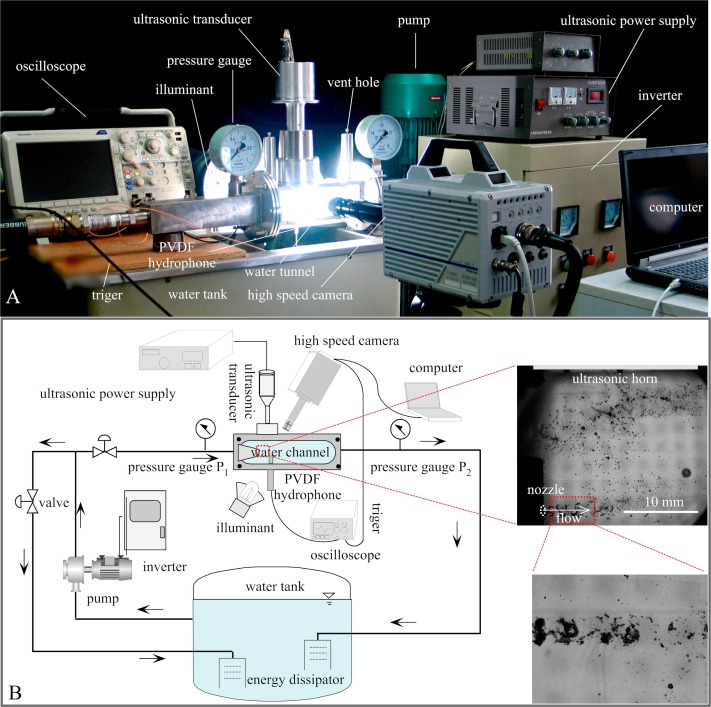Cavitation usually refers to the generation of cavities and the subsequent dynamic behaviors when a liquid suffers from a sufficient pressure drop. According to the mode of production, cavitation can usually be divided into acoustic cavitation, hydrodynamic cavitation, light cavitation and particle cavitation. Because of the high temperature and pressure, shock wave, micro jet during the collapse of cavitation bubbles, cavitation has been widely used in sonochemistry, biomedical, environmental science and many other fields.
However, the scaling-up of cavitation reactors in industry is difficult due to the shortcomings of intensity and processing scale of cavitation. Acoustic cavitation is usually high intensive but limited to the throughput, while hydrodynamic cavitation as an alternative method is easy to be scaled up but limited to the intensity.
Some attempts have been made to combine acoustic cavitation and hydrodynamic cavitation, only the method of combining the ultrasonic cavitation and hydrodynamic cavitation to taking place simultaneously in the same space, which is named as hydrodynamic-acoustic-cavitation (HAC), can make full use of the advantages of the two kinds of cavitation to maximizing the extent of hydroxyl radial generation.
Though observations on bubble clusters in either hydrodynamic cavitation or acoustic cavitation are plentiful, the direct observation of bubble clusters in hydrodynamic-acoustic cavitation (HAC) has not ever been reported. The mechanism of the synergistic effect still remains obscure.
Recently, researcher WU Pengfei and his colleagues from the Institute of Acoustics (IOA) of the Chinese Academy of Sciences explored the mechanism and dynamics of hydrodynamic-acoustic cavitation systematically, and provided a direct observation and a preliminary physical model on HAC.
The paper entitled “Mechanism and Dynamics of Hydrodynamic-Acoustic Cavitation (HAC)” was published online in Ultrasonics Sonochemistry.
From a physical viewpoint, hydrodynamic-acoustic-cavitation refers to cavitation in a liquid where acoustic wave and flow coexist.
The researchers established an experimental setup (Figure 1) consisting of a vertical multistage pump with an inverter to control the flow rate, a nozzle with a circular hole placed in a rectangular channel with two plexiglass windows mounted on front and back for optical observation, and a self-made ultrasonic transducer. Tap water was used in the experiment.

Figure 1. Experimental setup. (Image by WU Pengfei)
Via a high-speed camera equipped with a long-distance microscope, the researchers investigated bubble cloud dynamics in HAC and proposed a method for cavitation characterization (Figure 2) including a relationship between the light intensity distribution on lens sensor of the camera and the cavitation state variable.

Figure 2. Schematic illustration of the characterization method for cavitation. (Image by WU Pengfei)
Since cavitation is easily affected by the existence of the hydrophone in the measurement, like cavitation bubbles tend to gather around the hydrophone in this experiment, the optical detection method is rather noninvasive.
The researchers found that, compared with hydrodynamic cavitation or acoustic cavitation individually, HAC has significantly widened the range and enhanced the strength of cavitation (Figure 3), which may overcome the shortcomings of scale limitation of ultrasonic cavitation and low intensity of hydrodynamic cavitation.

Figure 3. Cavitation intensity distribution: (A) Hydrodynamic cavitation. (B) Hydrodynamic-Acoustic-Cavitation. (C) Acoustic cavitation. (Image by WU Pengfei)
Simulated results showed that the HAC bubble is far more violently expanded and collapsed compared with the hydrodynamic cavitation bubble and the acoustic cavitation bubble, which may be a mechanism why HAC has significantly enhanced the strength of cavitation.
What should be noted is that the present model is quite preliminary, the influence of bubble-bubble interaction, the instability of flow on bubble dynamics should be further considerate in future works.
Funding for this research came from the National Natural Science Foundation of China (No. 11674350 & 11174315).
Reference:
WU Pengfei, BAI Lixin, LIN Weijun, WANG Xiuming. Mechanism and Dynamics of Hydrodynamic-Acoustic Cavitation (HAC). Ultrasonics Sonochemistry (Volume 49, December 2018, Pages 89-96). DOI: 10.1016/j.ultsonch.2018.07.021.
Contact:
WANG Rongquan
Institute of Acoustics, Chinese Academy of Sciences, 100190 Beijing, China
E-mail: media@mail.ioa.ac.cn